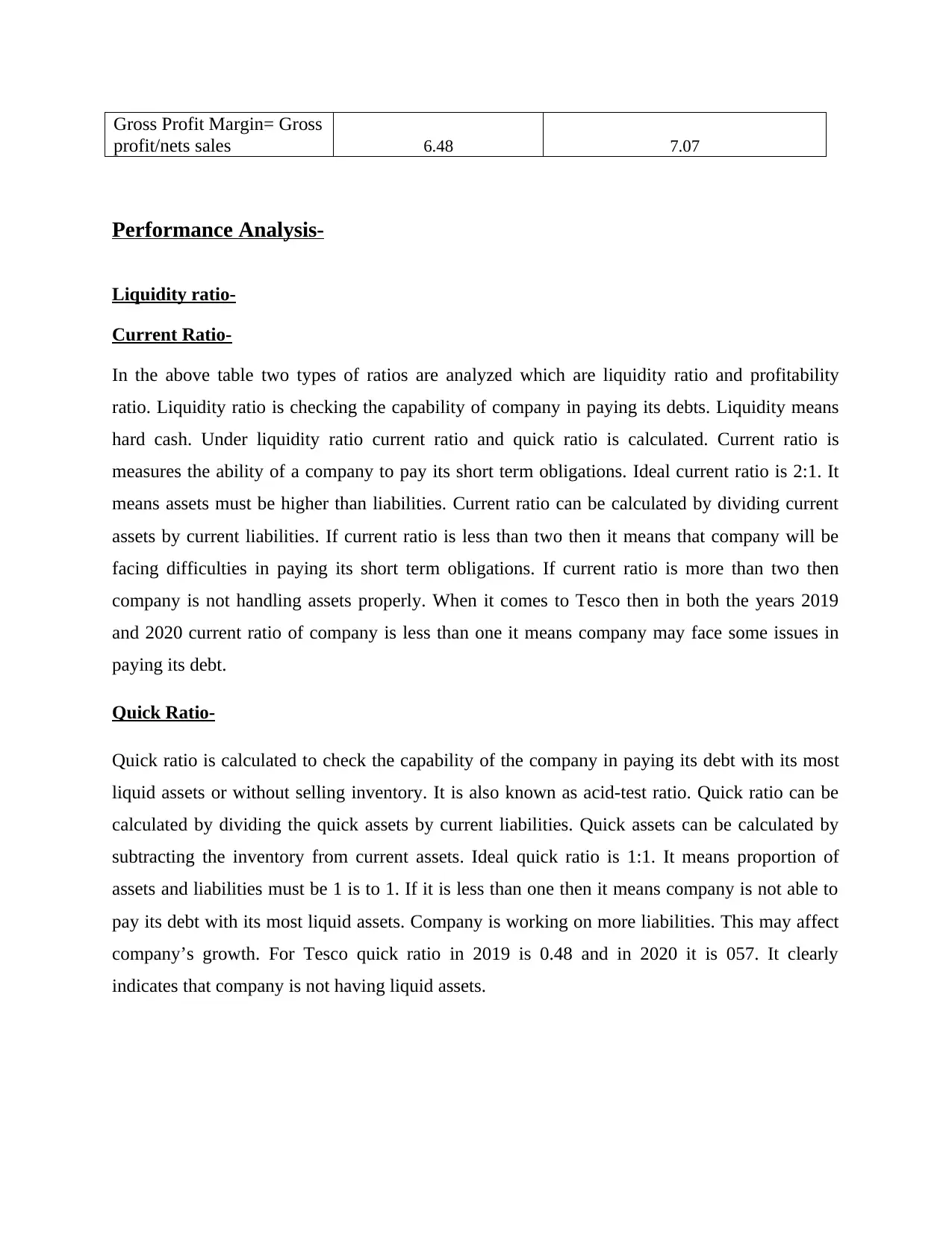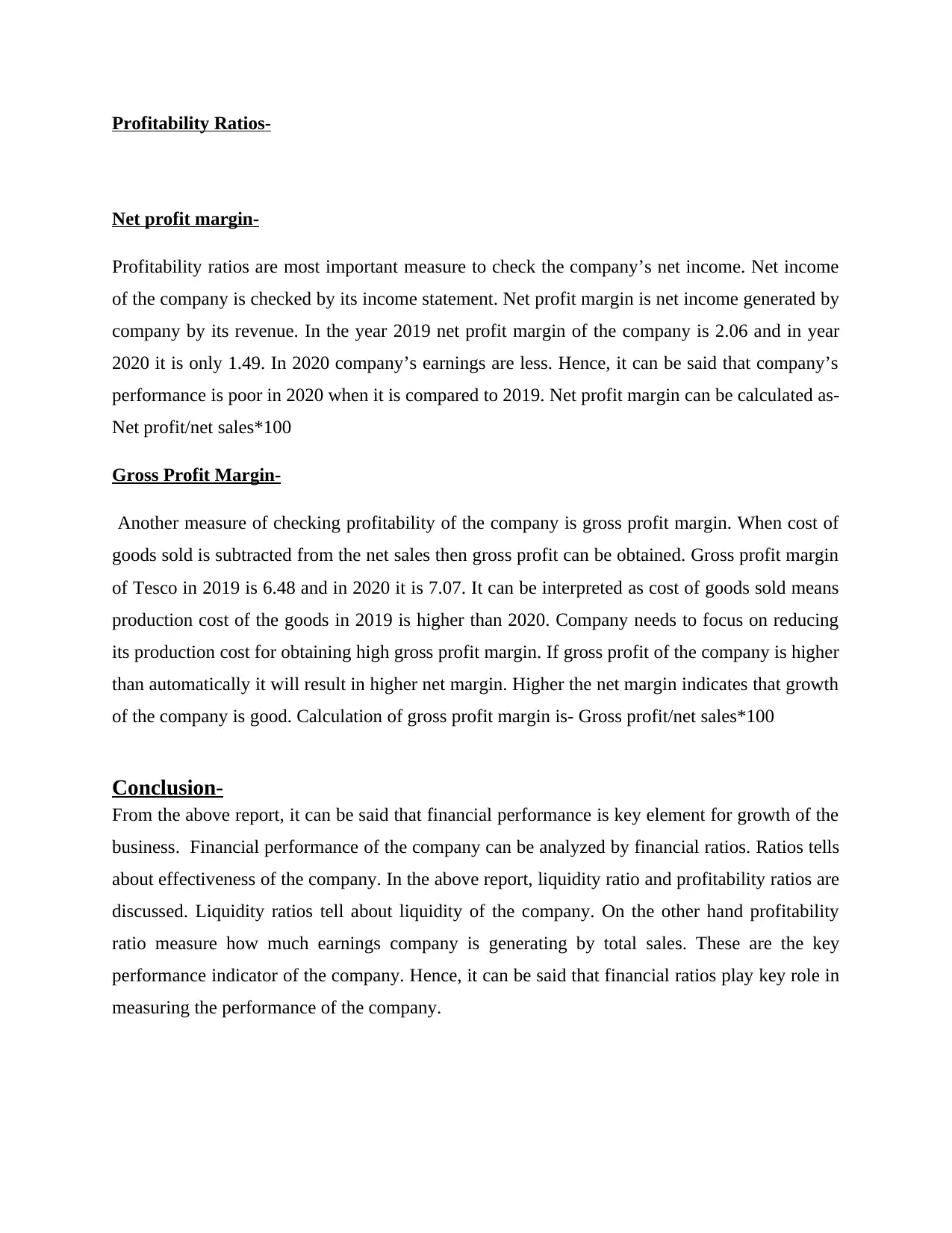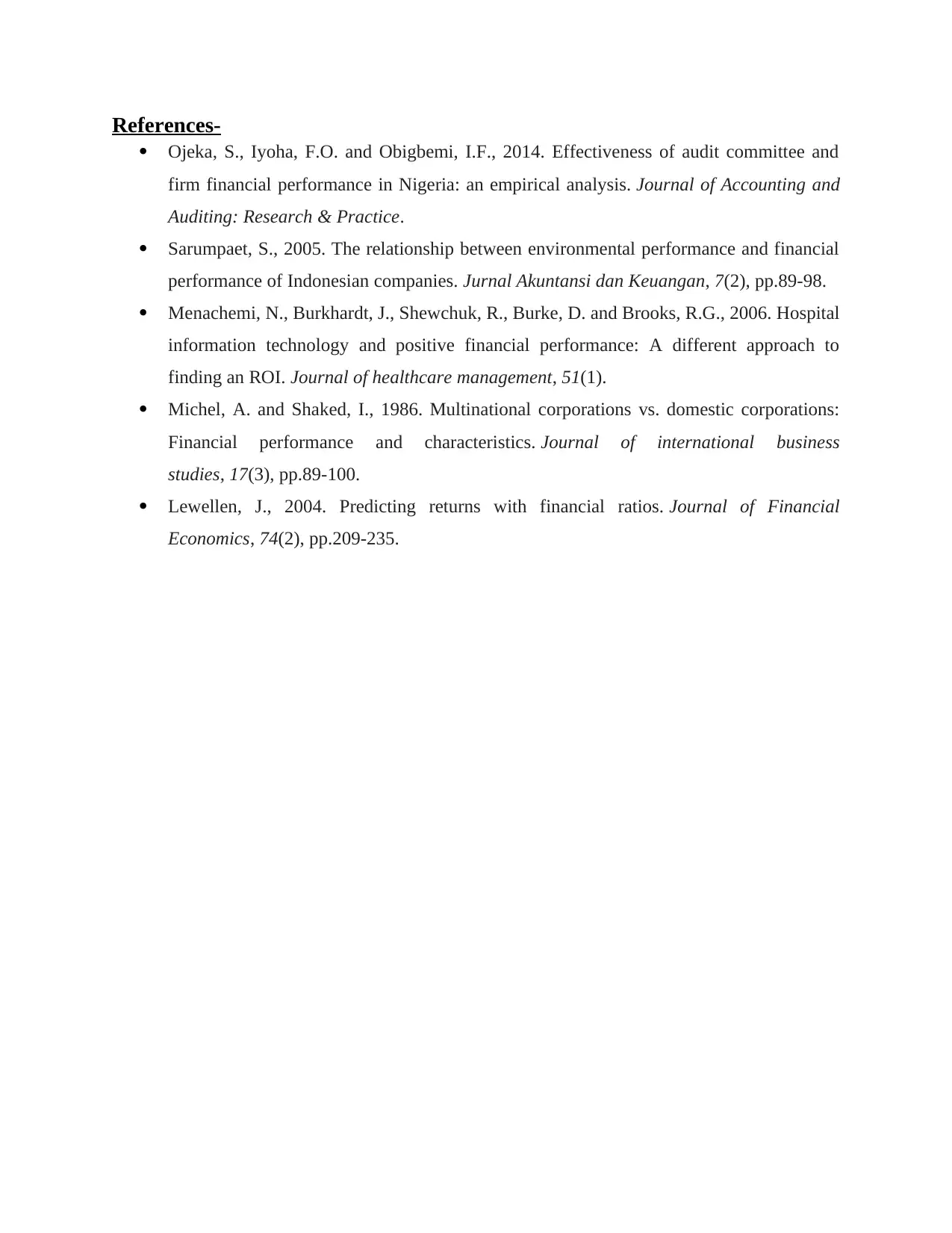Financial Performance Analysis Report: Tesco Corporation Analysis
VerifiedAdded on 2022/12/01
|6
|1077
|152
Report
AI Summary
This report provides a financial performance analysis of Tesco Corporation, a British multinational groceries retailer, using financial ratios. The analysis focuses on liquidity and profitability ratios to assess the company's financial health. Liquidity ratios, including the current ratio and quick ratio, are calculated and interpreted to evaluate Tesco's ability to meet its short-term obligations. The report notes that Tesco's current and quick ratios indicate potential challenges in paying short-term debts. Profitability ratios, such as net profit margin and gross profit margin, are also examined to gauge the company's earnings and efficiency. The analysis reveals a decrease in Tesco's net profit margin in 2020 compared to 2019, indicating poorer earnings. However, the gross profit margin increased, suggesting improvements in cost of goods sold. The report concludes that financial ratios are crucial for measuring a company's performance and highlights the importance of these metrics for Tesco's growth and financial management. References to relevant academic sources are included.

Financial
Performance Analysis
Performance Analysis
Paraphrase This Document
Need a fresh take? Get an instant paraphrase of this document with our AI Paraphraser

Table of Contents
Introduction-................................................................................................................................................3
Financial Ratios-..........................................................................................................................................3
Performance Analysis-................................................................................................................................3
Conclusion-.................................................................................................................................................3
References-..................................................................................................................................................3
Introduction-................................................................................................................................................3
Financial Ratios-..........................................................................................................................................3
Performance Analysis-................................................................................................................................3
Conclusion-.................................................................................................................................................3
References-..................................................................................................................................................3

Introduction-
In this report, financial performance of the company is analyzed. Measuring financial
performance of the company is a tough task. Various things need to be taken care of. Financial
performance of the company can be measured by using financial ratios. Various types of
financial ratios are discussed in the report. With the help of ratios, Company’s performance can
be compared with its past performance or other companies. Performance measurement gives idea
about where company needs changes in order to manage growth.
Company taken here is Tesco. It is British multinational groceries. It is headquartered in
England. It is ninth largest company by revenues. Company was founded in 1919 by jack cohen.
Revenue of the company is 64.760 billion.
Financial Ratios-
Tesco ratio
calculation
2019(In Billions) 2020(In Billions)
Liquidity Ratio
Current Assets 25.83 25.17
Current Liabilities 42.14 34.26
Current Ratio= Current
Assets/Current Liabilities 0.61 0.73
Quick Assets 20.49 20.52
Current Liabilities 42.14 34.16
Quick Ratio= Quick
Assets/current liabilities 0.48 0.57
Profitability Ratio
Net Profit 1322 971
Net sales 63911 64760
Net profit margin= Net
profit/net sales*100 2.06 1.49
Gross Profit 93.52 92.93
Net sales 100 100
In this report, financial performance of the company is analyzed. Measuring financial
performance of the company is a tough task. Various things need to be taken care of. Financial
performance of the company can be measured by using financial ratios. Various types of
financial ratios are discussed in the report. With the help of ratios, Company’s performance can
be compared with its past performance or other companies. Performance measurement gives idea
about where company needs changes in order to manage growth.
Company taken here is Tesco. It is British multinational groceries. It is headquartered in
England. It is ninth largest company by revenues. Company was founded in 1919 by jack cohen.
Revenue of the company is 64.760 billion.
Financial Ratios-
Tesco ratio
calculation
2019(In Billions) 2020(In Billions)
Liquidity Ratio
Current Assets 25.83 25.17
Current Liabilities 42.14 34.26
Current Ratio= Current
Assets/Current Liabilities 0.61 0.73
Quick Assets 20.49 20.52
Current Liabilities 42.14 34.16
Quick Ratio= Quick
Assets/current liabilities 0.48 0.57
Profitability Ratio
Net Profit 1322 971
Net sales 63911 64760
Net profit margin= Net
profit/net sales*100 2.06 1.49
Gross Profit 93.52 92.93
Net sales 100 100
⊘ This is a preview!⊘
Do you want full access?
Subscribe today to unlock all pages.

Trusted by 1+ million students worldwide

Gross Profit Margin= Gross
profit/nets sales 6.48 7.07
Performance Analysis-
Liquidity ratio-
Current Ratio-
In the above table two types of ratios are analyzed which are liquidity ratio and profitability
ratio. Liquidity ratio is checking the capability of company in paying its debts. Liquidity means
hard cash. Under liquidity ratio current ratio and quick ratio is calculated. Current ratio is
measures the ability of a company to pay its short term obligations. Ideal current ratio is 2:1. It
means assets must be higher than liabilities. Current ratio can be calculated by dividing current
assets by current liabilities. If current ratio is less than two then it means that company will be
facing difficulties in paying its short term obligations. If current ratio is more than two then
company is not handling assets properly. When it comes to Tesco then in both the years 2019
and 2020 current ratio of company is less than one it means company may face some issues in
paying its debt.
Quick Ratio-
Quick ratio is calculated to check the capability of the company in paying its debt with its most
liquid assets or without selling inventory. It is also known as acid-test ratio. Quick ratio can be
calculated by dividing the quick assets by current liabilities. Quick assets can be calculated by
subtracting the inventory from current assets. Ideal quick ratio is 1:1. It means proportion of
assets and liabilities must be 1 is to 1. If it is less than one then it means company is not able to
pay its debt with its most liquid assets. Company is working on more liabilities. This may affect
company’s growth. For Tesco quick ratio in 2019 is 0.48 and in 2020 it is 057. It clearly
indicates that company is not having liquid assets.
profit/nets sales 6.48 7.07
Performance Analysis-
Liquidity ratio-
Current Ratio-
In the above table two types of ratios are analyzed which are liquidity ratio and profitability
ratio. Liquidity ratio is checking the capability of company in paying its debts. Liquidity means
hard cash. Under liquidity ratio current ratio and quick ratio is calculated. Current ratio is
measures the ability of a company to pay its short term obligations. Ideal current ratio is 2:1. It
means assets must be higher than liabilities. Current ratio can be calculated by dividing current
assets by current liabilities. If current ratio is less than two then it means that company will be
facing difficulties in paying its short term obligations. If current ratio is more than two then
company is not handling assets properly. When it comes to Tesco then in both the years 2019
and 2020 current ratio of company is less than one it means company may face some issues in
paying its debt.
Quick Ratio-
Quick ratio is calculated to check the capability of the company in paying its debt with its most
liquid assets or without selling inventory. It is also known as acid-test ratio. Quick ratio can be
calculated by dividing the quick assets by current liabilities. Quick assets can be calculated by
subtracting the inventory from current assets. Ideal quick ratio is 1:1. It means proportion of
assets and liabilities must be 1 is to 1. If it is less than one then it means company is not able to
pay its debt with its most liquid assets. Company is working on more liabilities. This may affect
company’s growth. For Tesco quick ratio in 2019 is 0.48 and in 2020 it is 057. It clearly
indicates that company is not having liquid assets.
Paraphrase This Document
Need a fresh take? Get an instant paraphrase of this document with our AI Paraphraser

Profitability Ratios-
Net profit margin-
Profitability ratios are most important measure to check the company’s net income. Net income
of the company is checked by its income statement. Net profit margin is net income generated by
company by its revenue. In the year 2019 net profit margin of the company is 2.06 and in year
2020 it is only 1.49. In 2020 company’s earnings are less. Hence, it can be said that company’s
performance is poor in 2020 when it is compared to 2019. Net profit margin can be calculated as-
Net profit/net sales*100
Gross Profit Margin-
Another measure of checking profitability of the company is gross profit margin. When cost of
goods sold is subtracted from the net sales then gross profit can be obtained. Gross profit margin
of Tesco in 2019 is 6.48 and in 2020 it is 7.07. It can be interpreted as cost of goods sold means
production cost of the goods in 2019 is higher than 2020. Company needs to focus on reducing
its production cost for obtaining high gross profit margin. If gross profit of the company is higher
than automatically it will result in higher net margin. Higher the net margin indicates that growth
of the company is good. Calculation of gross profit margin is- Gross profit/net sales*100
Conclusion-
From the above report, it can be said that financial performance is key element for growth of the
business. Financial performance of the company can be analyzed by financial ratios. Ratios tells
about effectiveness of the company. In the above report, liquidity ratio and profitability ratios are
discussed. Liquidity ratios tell about liquidity of the company. On the other hand profitability
ratio measure how much earnings company is generating by total sales. These are the key
performance indicator of the company. Hence, it can be said that financial ratios play key role in
measuring the performance of the company.
Net profit margin-
Profitability ratios are most important measure to check the company’s net income. Net income
of the company is checked by its income statement. Net profit margin is net income generated by
company by its revenue. In the year 2019 net profit margin of the company is 2.06 and in year
2020 it is only 1.49. In 2020 company’s earnings are less. Hence, it can be said that company’s
performance is poor in 2020 when it is compared to 2019. Net profit margin can be calculated as-
Net profit/net sales*100
Gross Profit Margin-
Another measure of checking profitability of the company is gross profit margin. When cost of
goods sold is subtracted from the net sales then gross profit can be obtained. Gross profit margin
of Tesco in 2019 is 6.48 and in 2020 it is 7.07. It can be interpreted as cost of goods sold means
production cost of the goods in 2019 is higher than 2020. Company needs to focus on reducing
its production cost for obtaining high gross profit margin. If gross profit of the company is higher
than automatically it will result in higher net margin. Higher the net margin indicates that growth
of the company is good. Calculation of gross profit margin is- Gross profit/net sales*100
Conclusion-
From the above report, it can be said that financial performance is key element for growth of the
business. Financial performance of the company can be analyzed by financial ratios. Ratios tells
about effectiveness of the company. In the above report, liquidity ratio and profitability ratios are
discussed. Liquidity ratios tell about liquidity of the company. On the other hand profitability
ratio measure how much earnings company is generating by total sales. These are the key
performance indicator of the company. Hence, it can be said that financial ratios play key role in
measuring the performance of the company.

References-
Ojeka, S., Iyoha, F.O. and Obigbemi, I.F., 2014. Effectiveness of audit committee and
firm financial performance in Nigeria: an empirical analysis. Journal of Accounting and
Auditing: Research & Practice.
Sarumpaet, S., 2005. The relationship between environmental performance and financial
performance of Indonesian companies. Jurnal Akuntansi dan Keuangan, 7(2), pp.89-98.
Menachemi, N., Burkhardt, J., Shewchuk, R., Burke, D. and Brooks, R.G., 2006. Hospital
information technology and positive financial performance: A different approach to
finding an ROI. Journal of healthcare management, 51(1).
Michel, A. and Shaked, I., 1986. Multinational corporations vs. domestic corporations:
Financial performance and characteristics. Journal of international business
studies, 17(3), pp.89-100.
Lewellen, J., 2004. Predicting returns with financial ratios. Journal of Financial
Economics, 74(2), pp.209-235.
Ojeka, S., Iyoha, F.O. and Obigbemi, I.F., 2014. Effectiveness of audit committee and
firm financial performance in Nigeria: an empirical analysis. Journal of Accounting and
Auditing: Research & Practice.
Sarumpaet, S., 2005. The relationship between environmental performance and financial
performance of Indonesian companies. Jurnal Akuntansi dan Keuangan, 7(2), pp.89-98.
Menachemi, N., Burkhardt, J., Shewchuk, R., Burke, D. and Brooks, R.G., 2006. Hospital
information technology and positive financial performance: A different approach to
finding an ROI. Journal of healthcare management, 51(1).
Michel, A. and Shaked, I., 1986. Multinational corporations vs. domestic corporations:
Financial performance and characteristics. Journal of international business
studies, 17(3), pp.89-100.
Lewellen, J., 2004. Predicting returns with financial ratios. Journal of Financial
Economics, 74(2), pp.209-235.
⊘ This is a preview!⊘
Do you want full access?
Subscribe today to unlock all pages.

Trusted by 1+ million students worldwide
1 out of 6
Related Documents
Your All-in-One AI-Powered Toolkit for Academic Success.
+13062052269
info@desklib.com
Available 24*7 on WhatsApp / Email
![[object Object]](/_next/static/media/star-bottom.7253800d.svg)
Unlock your academic potential
Copyright © 2020–2025 A2Z Services. All Rights Reserved. Developed and managed by ZUCOL.





